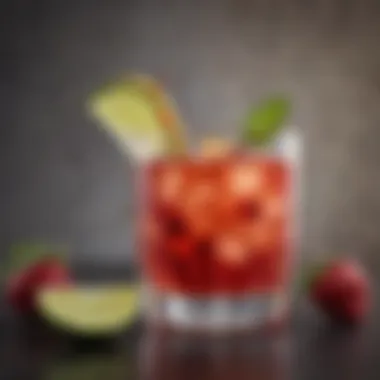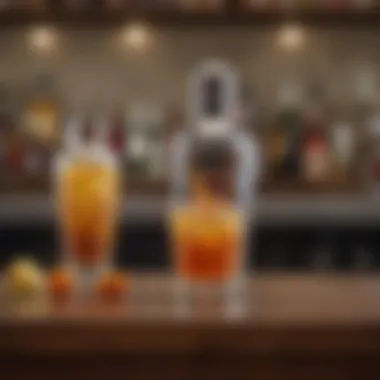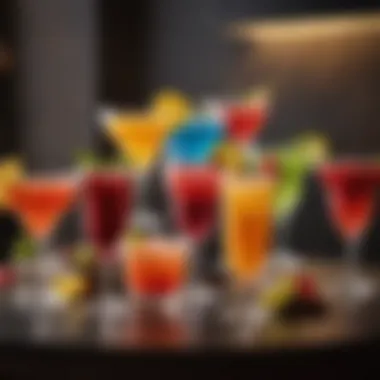Deliciously Simple Alcoholic Drinks to Craft at Home


Intro
Exploring the world of cocktails can seem intimidating, yet many simple alcoholic drinks can elevate a gathering or simply provide a moment of relaxation after a long day. This guide aims to demystify the process of making cocktails at home. With straightforward recipes and accessible ingredients, preparing your favorite drinks becomes a rewarding experience. People often shy away from mixing their own drinks, assuming it requires advanced skills or rare items. However, this article will show how you can become confident in your drink-making abilities with just a few essential recipes.
Recipe Overview
Recipe Name and Description
One popular and uncomplicated cocktail that serves as a great starting point is the Mojito. This refreshing drink originated from Cuba and perfectly balances the sweetness of sugar with the tartness of lime and the coolness of mint. It's an excellent choice for warm days or whenever you want something light and invigorating.
Cuisine Type
Cocktails such as Mojitos fit within the Caribbean and Latin American cuisine types. Yet, they are celebrated globally and can be found on menus all around the world.
Ingredients List
Detailed Ingredient Breakdown
The Mojito recipe includes the following ingredients:
- Fresh mint leaves
- Sugar or simple syrup
- Lime juice
- White rum
- Club soda
- Ice cubes
Each ingredient plays a vital role in the overall flavor profile. The fresh mint provides a cooling effect, while the lime juice adds a zesty touch. Rum, the traditional base spirit, enhances the drink’s depth, and club soda ensures a refreshing fizz.
Substitutions for Dietary Needs
For those who might want to adjust based on dietary preferences, consider these alternatives:
- Sugar: Agave syrup or stevia can serve as healthier sweeteners.
- Rum: For a non-alcoholic version, use additional club soda or a non-alcoholic rum alternative available on the market.
"Understanding the composition of your drinks not only makes for better-tasting cocktails but also enriches your mixing skills."
In summary, the Mojito exemplifies how simple ingredients can come together to create a delightful drink without the complexity often assumed to be necessary in cocktail preparation. With the right ingredients and simple techniques, making enjoyable cocktails at home is well within reach for anyone.
Intro to Simple Alcoholic Drinks
Creating drinks at home holds significant value, particularly in contemporary society where personal flair and individualization are increasingly appreciated. Simple alcoholic drinks allow for flexibility and creativity, accommodating varying tastes and preferences without the need for professional equipment or specialized knowledge. The concept of mixing at home extends beyond just crafting beverages; it is about creating experiences and memories. Home-made drinks elevate ordinary moments and transform them into meaningful occasions.
Defining Simple Alcoholic Drinks
Simple alcoholic drinks are those that require minimal ingredients and straightforward preparation methods. Typically, they do not necessitate advanced techniques or lengthy processes. Some examples include the classic Whiskey Sour, or basic combinations like Rum and Coke. These drinks reflect a balance of flavors without overwhelming complexity.
The core of these drinks lies in their accessibility. Most recipes can be made with common spirits, mixers that can be easily found in grocery stores, and occasional garnishes. This emphasis on simplicity makes it possible for anyone to enjoy the satisfaction of crafting their own beverage, irrespective of prior experience or expertise.
The Appeal of Home-Made Beverages
There is a distinct charm in home-made beverages that encourages individuals to engage with their culinary creativity. This appeal stems from several factors:
- Personalization: Homemade drinks can be tailored to fit personal tastes and dietary restrictions. This flexibility enables enthusiasts to explore unique flavor combinations that may not be available in commercial offerings.
- Cost-Effectiveness: Making drinks at home is often more economical than purchasing them at bars or restaurants. The initial investment in spirits and mixers can provide substantial returns, allowing for multiple servings.
- Social Interaction: Mixing drinks can serve as a social activity, whether it is preparing cocktails for friends or experimenting with new recipes during gatherings. It fosters connection through shared experiences.
"The act of mixing drinks invites a sense of adventure and creativity into the home environment, encouraging experimentation in flavors and presentations."
In summary, the rise of simple alcoholic drinks speaks to a deeper desire for creativity, cost-effectiveness, and social interaction in our everyday lives. Understanding these drinks and preparing them at home can enhance one’s appreciation of mixology while also offering practical benefits.
Essential Ingredients for Easy Mixology
The foundation of any great cocktail begins with the right ingredients. Understanding the essential components of easy mixology is important for anyone wishing to create memorable drinks at home. By having a well-stocked bar, you can prepare a wide variety of cocktails, experiment with flavors. This section addresses the importance of having these staples on hand. It emphasizes convenience, versatility, and the ability to make delightful beverages without hunting for hard-to-find ingredients.
Common Spirits to Stock
When considering common spirits, three key types should be included in your home bar: vodka, gin, and whiskey. Vodka serves as a versatile base, well-suited for numerous cocktails. It has a neutral flavor that allows other ingredients to shine. Gin adds complexity due to its botanical profile, making it perfect for refreshing drinks. Whiskey, whether bourbon or rye, provides depth and warmth and is a must for classic cocktails.
- Vodka: Known for its clean taste, vodka can be used in many drinks, from simple sodas to intricate cocktails.
- Gin: Offers a herbal element and works exceptionally well in drinks like gin and tonic and martinis.
- Whiskey: Adds richness and can be enjoyed in a whisky sour or straight, appealing to diverse preferences.
Additional spirits, like rum and tequila, can enhance your selection, ensuring you can make tropical drinks or vibrant margaritas as well. A balanced selection helps broaden your mixology capabilities.
Mixers and Other Necessities
Mixers are vital for creating a harmonious blend of flavors in cocktails. Basic mixers include tonic water, soda, and various juices. Tonic water brings out the herbal notes in gin, while tonic water is perfect for vodka-based drinks. Fresh juices, such as lime or orange, elevate drinks and provide a burst of flavor.
It's also wise to consider a variety of bitters, such as Angostura or orange bitters. These small amounts can alter the taste of your drinks profoundly, adding depth and character.
- Soda Water: Great for lightening drinks and adding sparkle.
- Tonic Water: Pairs well with gin, enhancing botanical flavors.
- Fruit Juices: Freshly squeezed is best, like citrus for tangy cocktails.
Stocking these mixers allows you to quickly throw together refreshing drinks. Having a variety leads to more creative possibilities, ensuring you'll find the perfect accompaniment for your chosen spirit.
Garnishes and Enhancements
Garnishes are not merely for aesthetics; they play a crucial role in the overall drinking experience. A well-chosen garnish can enhance flavor and aroma. Basic garnishes are simple yet impactful. Often found, these include lemon and lime wedges, fresh herbs like mint, or even olives for martinis.


Consider also using flavored syrups, which add sweetness and complexity to cocktails.
- Lemon/Lime Wedges: Bright acidity that complements many spirits.
- Fresh Herbs: Adds a fragrant note and beautifies the drink.
- Flavored Syrups: Can create a new layer of flavor, elevating cocktails.
Additionally, ice quality matters. Using clear, well-formed cubes versus crushed ice can change the texture and temperature of the drink. By taking the time to choose appropriate garnishes and enhancements, you can create drinks that not only please the palate but also the eyes.
Properly selected ingredients can transform a simple drink into an experience.
Classic Cocktails to Try
Classic cocktails hold a significant place in the world of home mixology. They represent timeless recipes that have stood the test of time, serving as a foundation for countless variations. Preparing classic cocktails can be both educational and rewarding. They introduce novice mixers to basic techniques while allowing seasoned enthusiasts to refine their skills. Each cocktail offers a glimpse into the history and culture of its origins, showcasing how simple ingredients can be transformed into delightful beverages.
Whiskey Sour
The Whiskey Sour is a staple cocktail that beautifully balances the robustness of whiskey with the tartness of lemon juice. This drink is not only straightforward to prepare but also an excellent introduction to mixing cocktails. To craft a traditional Whiskey Sour, you will need:
- 2 ounces of whiskey (bourbon is commonly used)
- 3/4 ounce of fresh lemon juice
- 1/2 ounce of simple syrup
- Combine ingredients: Pour the whiskey, lemon juice, and simple syrup into a shaker filled with ice.
- Shake: Vigorously shake for about 15 seconds.
- Strain and serve: Strain into an old-fashioned glass filled with ice or a coupe glass, depending on your preference. You may garnish with a cherry or a slice of orange for presentation.
The beauty of the Whiskey Sour lies in its versatility. You can adjust the sweetness and acidity to your taste. Additionally, variations such as adding egg white can create a smoother texture.
Gin and Tonic
The Gin and Tonic is another quintessential cocktail, appreciated for its refreshing nature. It requires minimal ingredients, making it ideal for at-home mixing. The basic components include:
- 2 ounces of gin
- 4 ounces of tonic water
- Lime wedge or slice for garnish
- Fill a glass with ice: This helps keep the drink chilled.
- Pour gin: Add the gin over the ice.
- Add tonic: Top off with tonic water gently to maintain the fizziness.
- Garnish and serve: Squeeze a lime wedge into the drink and drop it in for added flavor.
This cocktail is known for its hydrating qualities, making it a popular choice during warm weather. You can experiment by using different gin varieties or flavored tonic waters.
Vodka Soda
The Vodka Soda is a favored choice because of its simplicity and low-calorie nature. The drink does not mask the character of vodka while offering a refreshing taste. To prepare a Vodka Soda, gather these ingredients:
- 1.5 ounces of vodka
- 4 ounces of club soda
- Lemon or lime wedge for garnish
- Add ice to the glass: Fill a highball glass with ice cubes.
- Pour vodka: Add the vodka over the ice.
- Top with soda: Fill the glass with club soda and stir gently.
- Garnish: Add a lemon or lime wedge to enhance the flavor.
The Vodka Soda is an excellent canvas for infused vodkas or flavored sodas, allowing you to personalize the drink further. Its simplicity does not detract from its enjoyment, making it a favorite among many.
Rum and Coke
The Rum and Coke is a classic highball that has become iconic in its own right. Its straightforward recipe requires few ingredients. You will need:
- 2 ounces of rum
- 4 ounces of cola
- Lime wedge for garnish
- Fill a glass with ice: Use a classic highball glass for serving.
- Add rum: Pour the rum over the ice.
- Combine with cola: Top with cola and stir gently to mix.
- Garnish: Serve with a lime wedge to brighten the flavors.
The beauty of the Rum and Coke lies in its adaptability; you may choose light rum for a sweeter taste or dark rum for a more robust flavor. It pairs well with a variety of foods, making it an ideal choice for casual gatherings.
Refreshing Summer Drinks
Refreshing summer drinks are essential for any home bartending experience, especially when the heat becomes intense. These beverages provide not only hydration but also a burst of flavor that complements warm days and social gatherings. They are typically light and invigorating, making them perfect for sipping by the pool or during outdoor barbecues. The vibrant ingredients often used elevate the aesthetic and appeal of summer cocktails, which can take your mixing skills to new levels. Furthermore, the simplicity of these recipes allows anyone to enjoy the art of mixology without extensive expertise.
Mojito
The Mojito is a classic Cuban cocktail that combines sweetness, citrus, and refreshing mint. To prepare a traditional Mojito, you will need white rum, fresh mint leaves, lime juice, sugar, and soda water.
- Muddle fresh mint leaves with sugar and lime juice in a glass to release the mint’s essential oils.
- Add white rum and fill the glass with ice cubes.
- Top off with soda water and stir gently.
- Garnish with a sprig of mint and a lime wedge for presentation.
The magic of a Mojito lies not only in its flavor but also in the refreshing sensation it delivers on a hot day. The combination of mint and lime creates a cooling effect that is invigorating. This drink is versatile; feel free to experiment by adding fruits like strawberries or blueberries to create variations.
Pimm’s Cup
Pimm's Cup is a quintessential British summer drink, renowned for its fruity and herbal flavor. The base is Pimm's No. 1, a gin-based liqueur infused with various herbs and spices, which is then blended with lemonade or lemon-lime soda. To construct this drink:
- Fill a tall glass with ice.
- Pour Pimm’s No. 1 over ice, typically in a ratio of 1 part to 3 parts mixer.
- Add slices of seasonal fruits like cucumbers, strawberries, oranges, and even herbs like mint for added aroma.
- Stir gently to combine the flavors.
This drink presents a beautiful and colorful appearance, making it ideal for summer gatherings. Furthermore, the mix of fresh ingredients makes each sip light and enjoyable.
Tequila Sunrise
Tequila Sunrise offers a visually stunning presentation alongside its delightful fruitiness. Made with tequila, orange juice, and grenadine, this drink mimics the colors of a sunrise. Creating a Tequila Sunrise is direct:
- Pour tequila into a glass filled with ice.
- Add fresh orange juice until the glass is nearly full.
- Slowly drizzle grenadine down the side of the glass so it settles at the bottom.
- Garnish with an orange slice and a cherry.
The result is a layered effect that not only looks stunning but also provides a refreshing citrus taste. It’s easy to make, which makes it perfect for parties or casual gatherings.


Remember: The key to mastering summer drinks is to utilize fresh ingredients. It enhances the flavor and elevates the experience of each sip, making your efforts worthwhile.
Winter Warmers for the Cold Months
During the chilly months, the appeal of warming alcoholic beverages becomes more pronounced. Winter warmers serve as both a means of heat and comfort. They often bring together rich flavors and aromatic spices that can evoke a sense of coziness. This section will delve into several classic winter drinks known for their soothing properties.
These beverages are not only delicious but also simple to prepare at home. Understanding how to make them enhances not only your mixing skills but also your enjoyment of the seasonal festivities. Moreover, winter warmers can be tailored to suit personal preferences, allowing for creativity in mixology.
Hot Toddy
The Hot Toddy is a classic choice when seeking warmth. Originating as a medicinal drink, it combines hot water, whiskey, honey, and lemon. The balance between sweetness and acidity makes it quite enjoyable. To prepare a Hot Toddy, you need to follow these basic steps:
- Boil water and let it cool slightly.
- Pour about one ounce of whiskey into a cup.
- Add one tablespoon of honey and the juice of half a lemon.
- Fill the rest with hot water.
- Stir until everything is dissolved.
Tips: Add spices like cinnamon or cloves for additional warmth and flavor. Some also enjoy using herbal tea as a base to add another layer of complexity.
Mulled Wine
Mulled Wine is synonymous with winter gatherings. It combines red wine with spices and fruits, creating an aromatic experience. The key ingredients typically include:
- Red wine: A full-bodied variety is often preferred.
- Spices: Common choices are cinnamon, star anise, and nutmeg.
- Fruits: Oranges and lemons add brightness.
To create your own Mulled Wine:
- Pour a bottle of wine into a pot.
- Add the spices and sliced fruits.
- Warm gently, avoiding boiling, to allow flavors to meld.
- Let it sit for about 20-30 minutes.
- Strain and serve warm.
This drink not only provides warmth but also a festive aroma that fills the room.
Irish Coffee
Irish Coffee combines the richness of coffee with the smoothness of Irish whiskey. It is usually topped with a layer of cream, making it a luxurious drink suitable for colder days.
To make a proper Irish Coffee:
- Brew a strong cup of coffee.
- In a glass, add one to two ounces of Irish whiskey.
- Stir in sugar to taste.
- Fill with the hot coffee until nearly full.
- Finally, float whipped cream on top by pouring it over the back of a spoon.
The balance of hot coffee with the cool cream creates a wonderful drinking experience.
In summary, winter warmers like Hot Toddy, Mulled Wine, and Irish Coffee not only bring comfort but also a sense of tradition. Their preparation methods are straightforward, encouraging experimentation and adaptation based on personal taste. Enjoy these drinks as you embrace the warmth of your home during the cold months.
Innovative Variations on Traditional Drinks
Innovating traditional drinks provides a fascinating pathway for both new and experienced mixologists. This article highlights how creativity in cocktails can enhance the drinking experience while still retaining simple preparation methods. By exploring innovative variations, you open yourself to a broader range of flavors and personal taste preferences. This flexibility allows you to craft drinks that not only please the palate but also impress guests at gatherings.
Experimenting with drinks adds an element of fun to home mixology. It encourages a deeper appreciation for the ingredients and the process of making cocktails. Furthermore, innovative variations can adapt classic recipes to accommodate dietary restrictions or seasonal ingredients, promoting sustainability in drink preparation.
Spiced Rum Variations
Spiced rum offers a delightful base for experimentation. Traditional spiced rum typically combines white rum with various spices, yielding a complex flavor profile. This versatility allows for countless variations.
To create a unique spiced rum cocktail, consider the following:
- Citrus Infusion: Add fresh lime or orange juice to complement the rum's spices.
- Herbaceous Twist: Incorporate mint or basil for a refreshing herbal quality.
- Exotic Mix: Blend in some coconut cream and pineapple juice for a tropical vibe.
These variations can transform a simple spiced rum into an eye-catching and flavorful cocktail that remains easy to prepare. The balance between classic flavors and new elements attracts adventurous drinkers, making for a memorable experience.
Infused Spirits
Infusing spirits can lead to exciting variations that enhance drink profiles. This method involves steeping various flavors into a base spirit over time. The process may sound complex but is relatively straightforward. The importance of infusion is in its ability to create unique flavor combinations tailored to individual preferences.
To start infusing spirits, you can use:
- Fruits: Peaches, strawberries, and lemons work well for a fresh flavor.
- Herbs: Rosemary, thyme, and mint add depth and aroma.
- Spices: Cinnamon sticks, vanilla beans, or star anise can introduce warmth and complexity.
The infusion process typically takes about 3 to 5 days. Ensure to taste it regularly to achieve the desired flavor intensity.
Infused spirits can be enjoyed neat or used as a base to create unique cocktails, giving drinkers a palate-pleasing experience that feels personalized and artisanal. This level of customization is appealing, ensuring that every drink can be crafted to match the occasion or individual preference.
Alcohol-Free Alternatives
In recent years, the conversation around alcoholic drinks has evolved to include alcohol-free options. This section highlights the benefits of exploring alcohol-free alternatives, making it relevant for those who prefer not to consume alcohol yet wish to enjoy the experience of cocktail culture.
Alcohol-free drinks can cater to many situations. Whether individuals are abstaining for health reasons, designated driving, or simply preferring to remain sober, these alternatives make social occasions more enjoyable. Such options can be refreshing and exciting. Moreover, they allow creatvity in drink-making without the intoxicating effects.
Offering alcohol-free alternatives is a thoughtful approach to catering to all preferences. It encourages inclusivity, ensuring no one is left out during gatherings.
Mocktail Recipes to Enjoy
Mocktails serve as the non-alcoholic stars of the cocktail world. Creating mocktails is an excellent way to indulge in complex flavors without any alcohol. Below are a few ideas to get started:


- Virgin Mojito: Mix fresh mint leaves, lime juice, and sugar, then top with soda water. Garnish with lime and mint for visual appeal.
- Nojito: Combine coconut water with a hint of mint and lime for a tropical twist.
- Berry Fizz: Muddle fresh berries, add lemon juice, and top with soda water or tonic for a refreshing drink.
Mocktails elevate any gathering, showcasing creative approaches to enjoyable drinks without alcohol.
Using Non-Alcoholic Spirits
The market for non-alcoholic spirits has expanded significantly. These products mimic the complexity of traditional spirits without the alcohol content. This opens new avenues for crafting drinks with the same elegance as their alcoholic counterparts. Some notable brands include Seedlip, Lyre�’s, and Ritual Zero Proof.
Using these non-alcoholic spirits allows enthusiasts to experiment more freely in their mixology. Traditional cocktails can be reimagined.
- Non-Alcoholic Gin and Tonic: Mix your choice of non-alcoholic gin with tonic water, served in a highball glass with plenty of ice and a slice of cucumber.
- Zero Proof Negroni: Substitute the gin, Campari, and vermouth with non-alcoholic versions to capture the original cocktail's spirit without alcohol.
This versatility means that no event has to lack in taste or creativity. Non-alcoholic spirits genuinely enhance the enjoyment of social gatherings without alcohol, allowing more people to partake.
"The rise of alcohol-free options is reshaping how we think about social drinking, fostering creativity in beverage making."
In summary, alcohol-free alternatives not only provide enjoyable experiences but also cater to the needs of all attendees at social events. Mocktails and non-alcoholic spirits augment the drink selection, highlighting that enjoyment does not have to be synonymous with alcohol.
Tips for Successful Mixing
Mixology is an art that benefits from a few key principles. For those venturing into the world of creating alcoholic drinks at home, understanding tips for successful mixing enhances both the quality and enjoyment of the beverages. With simple techniques, anyone can elevate their drink-making experience.
Understanding Measurements
Accurate measurements are the foundation of great cocktails. Using precise quantities of ingredients ensures that the flavors are balanced. An imbalance can lead to an overly sweet or bitter drink. Generally, a jigger, which measures one and one-half ounces, is a common tool for this task. However, if you don't have a jigger, using a standard kitchen measuring spoon works as well.
When following drink recipes, adhering to suggested measurements allows one to replicate their favorite drinks consistently. Over time, as confidence builds, adjusting the measurements to personal preference becomes simpler. It’s not just about volume; knowing the ratios can change a drink from mediocre to outstanding. For example, in a whiskey sour, the typical ratio is two parts whiskey to one part lemon juice. Keeping a few basic ratios in mind can simplify the mixing process significantly.
Importance of Fresh Ingredients
The use of fresh ingredients vastly improves the quality of drinks. Fresh fruits, herbs, and juices not only enhance flavor but also contribute to the aroma and appearance of the cocktail. For instance, a mojito made with fresh mint and lime delivers a vibrant taste compared to using bottled alternatives.
Seasonal ingredients can also inspire creativity. Certain flavors improve depending on the time of year, making them perfect for themed drinks. Here are some reasons why fresh ingredients matter:
- Flavor Profile: Fresh components lead to brighter, more dynamic flavors.
- Nutritional Value: Fresh ingredients might have better nutritional benefits compared to preserved ones.
- Presentation: Fresh garnishes can make a drink visually appealing, adding to the overall experience.
In summary, understanding measurements and prioritizing fresh ingredients enrich the art of mixing. By observing these guidelines, anyone can achieve satisfying results in their home bartending endeavors.
Serving and Presentation
Serving and presentation is a critical aspect when it comes to enjoying alcoholic drinks at home. A well-presented drink not only enhances visual appeal but also elevates the overall drinking experience. It invites the drinker to engage with the beverage in a different way, making it more enjoyable. Good presentation can also lead to enhanced flavors through the use of specific glassware and garnishes that complement the drink.
Choosing the Right Glassware
The choice of glassware can significantly affect the perception of a cocktail. Different drinks require different types of glasses. For example, a classic Whiskey Sour is best served in an old-fashioned glass, while a Gin and Tonic is more refreshing in a tall glass. The design and shape of the glass can impact the aroma and taste of a drink, making the selection process essential.
Here are some key points to consider:
- Functionality: Ensure the glass fits well in hand and has a balanced feel. For drinks served shaken or stirred, a slimmer glass might be preferred while bubbly drinks benefit from wider glasses to enhance the carbonation.
- Style: Matching the glassware with the theme of the drink adds another layer of enjoyment. A vibrant Pimm’s Cup looks especially appealing in a clear highball glass, allowing the colorful ingredients to stand out.
- Convenience: When entertaining, use glassware that is easy to handle and clean. Avoid overly intricate glassware that may complicate the serving process.
Garnishing Techniques
Garnishes serve more than just a decorative function. They can enhance flavor, aroma, and visual appeal of the drink. Simple yet effective garnishing techniques can transform a basic cocktail into a stunning presentation.
To effectively use garnishes, consider the following:
- Herbs: Fresh herbs, such as mint or basil, can add aromatic qualities to drinks such as Mojitos or Gin and Tonics.
- Fruits: Slices of lemons, limes, or fresh berries can add both color and tangy flavor to a cocktail. Placing them neatly on the rim or dropping them in can elevate presentation.
- Zests: Citrus peels add brightness. A lemon twist can create a fragrant finish to drinks like Vodka Soda.
“A well-garnished drink is like the cherry on top. It captivates the eye and engages the palate.”
Closure: Embracing Simplicity in Mixology
In the realm of cocktail creation, simplicity often yields the most satisfying results. This article underscores the significant benefits of home mixology, where uncomplicated recipes can lead to delightful experiences. Homemade alcoholic drinks do not require extensive training or elaborate equipment. Instead, with a few key ingredients and thoughtful preparation, anyone can craft flavorful beverages in their own kitchen. This accessibility is one of the core pillars of mixology that many overlook.
Making drinks at home fosters a sense of accomplishment and can be a rewarding hobby. The basic principles of drink-making form the foundation for innovation. When individuals understand the fundamentals, they feel more confident to explore and create variations. Whether it is experimenting with new flavors or tweaking traditional recipes, the joy of crafting one’s own cocktails is immeasurable.
"Simplicity is the ultimate sophistication."
This journey into simplicity brings essential considerations to the forefront. Overcomplicated recipes may deter novice enthusiasts, leading to frustrating experiences. The takeaway from this article is that delicious drinks ought to be approachable. Consumers should not feel intimidated by the idea of mixology. Instead, they can view it as an enjoyable activity.
The Joy of Home-Made Drinks
There exists a unique pleasure in preparing drinks at home. The atmosphere becomes more inviting, and a personal touch in serving cocktails adds to their charm. Home-made drinks allow the creator to control every aspect, from choosing fresh ingredients to deciding on the presentation. This customization adds layers of satisfaction to the experience.
Moreover, the act of sharing these creations with friends and family amplifies the joy. A well-mixed drink can enhance gatherings, providing opportunities for connection and conversation. Enjoying these beverages in the comfort of one's space creates treasured memories that emerge from simple acts of hospitality.
Encouragement for Experimentation
Experimentation is encouraged in the art of drink-making. With a basic understanding of ingredients and techniques, individuals can deviate from the norm. Substituting a spirit or trying a new mixer can lead to delightful surprises.
In a world filled with variety, mixing drinks becomes a personal journey. Here are a few tips for those looking to explore:
- Start Small: Begin with altering recipes you are familiar with.
- Mix Flavors: Combine different liqueurs or spirits to discover interesting flavor profiles.
- Balance is Key: Pay attention to the balance of sweet, sour, and bitter elements.
- Keep Track: Make notes on what works and what does not; this helps refine your technique.
This willingness to try new combinations can lead to discovering signature drinks that reflect personal taste. As with all art forms, the process of discovery is key to growth. Through these simple acts, creativity flourishes. The bar is set high with the notion that anyone can become a mixology aficionado at home.















